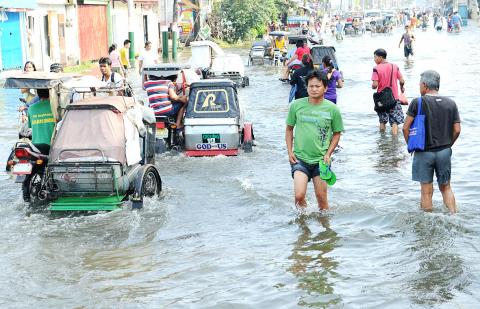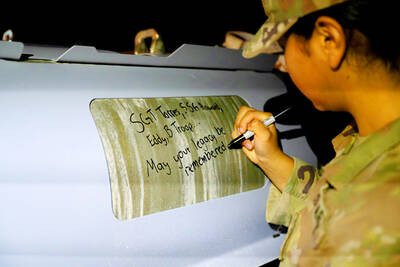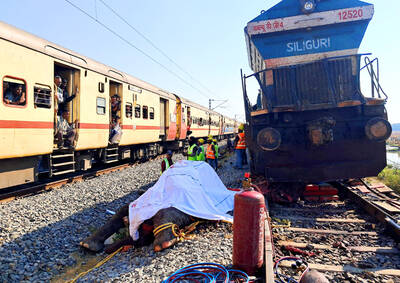Deadly floods, power blackouts and traffic gridlock — many of Asia’s biggest cities are buckling under the strain of rapid economic development, extreme weather and an exodus from the countryside.
Poor strategic planning, paltry investment in infrastructure and a lack of political will have also left the region’s overcrowded metropolises highly vulnerable to the pressures of climate change, experts say.
Over the past year, Bangkok and Manila have been hit by the most devastating floods in decades, while India recently suffered the world’s worst-ever power blackout due to surging demand from industry, homes and offices.

Photo: AFP
It is a situation that is increasingly out of step with growing affluence in Asia, where millions of people escape from poverty every year but face a return to third-world conditions when disaster strikes.
Many Asian cities are “lagging behind in infrastructure provision, whether we talk about sewers, roads or electricity supplies,” said Sun Sheng Han, an urban planning expert at Australia’s University of Melbourne.
At the heart of the problem lies a lack of vision in a region where urban development policies reflect a mixture of “political goals and economic ambitions,” he said.
In the Thai capital Bangkok, years of aggressive groundwater extraction to meet the growing needs of its factories and 12 million inhabitants have taken a heavy toll.
Yet despite warnings the city — built on swampland and slowly sinking — risks being below sea level in half a century from now, a building boom shows no sign of abating with apartment towers mushrooming around the city.
Rapid urbanization that blocks natural waterways and neglected drainage systems are also seen as major factors behind the deadly floods that have battered the Philippine capital Manila this month.
On the outskirts of Manila, vital forested areas have been destroyed to make way for housing developments catering to growing middle and upper classes.
Within the city, squatters — attracted by economic opportunities — often build shanties on river banks, storm drains and canals, dumping garbage and impeding the flow of waterways.
However, perhaps nowhere are the challenges more stark than in India, where a two-day power blackout across half the country last month left more than 600 million people without supplies as high demand overwhelmed the grid.
Yet even now, only 30 percent of India’s 1.2 billion population live in cities, far lower than the 50.6 percent in China or the 70 to 80 percent in developed countries, according to a UN report released last year.
It forecasts India’s urban population will grow by 60 percent from its current level of 377 million, to 606 million, by 2030.
As air conditioners, microwave ovens, washing machines and other electrical items become increasingly popular with the country’s burgeoning middle class, the strains on the power sector are expected to increase.
According to the McKinsey Global Institute research center, India also needs 350km to 400km of new metros and subways a year and 19,000km to 25,000km of roads.
Mumbai — with 20,000 inhabitants per square kilometer — is one of the world’s most densely populated cities.
Its packed suburban trains are estimated to carry 7 million people every day, and each year more than 3,000 people are killed on the railway network, sometimes falling from open doors or hit while crossing the tracks.
“The rush hour is the biggest issue. There are times it’s so crowded, it’s difficult to breathe,” said Sudhir Gadgil, 62, an office assistant in Mumbai’s southern business district, whose commute to work by train takes one-and-a-half hours.
In neighboring Bangladesh, the capital Dhaka is facing the worst transport infrastructure problems in its history.
Soon after taking over in January 2009, the government promised to tackle the crisis with an array of ambitious rail, bus and road projects, but most are still in the design stage.
“Dhaka already is a moribund city. It’s dying fast and I see no hope how we can save it,” said Shamsul Haq, the country’s top transport expert and a professor at Bangladesh University of Engineering and Technology.
However, traffic jams are by no means unique to Bangladesh, and in many teeming cities the prospect of abandoning city life altogether is becoming increasingly appealing for some frustrated residents.
In Jakarta, ranked bottom of 23 cities in Frost & Sullivan’s 2011 global commuter satisfaction survey, experts predict that given its ageing bus network and lack of train system, the capital will reach total gridlock by 2014.
“If it doesn’t change in the next five years, I’m moving to Bali for a more peaceful life,” freelance writer Dian Agustino said in one of the city’s shopping malls.

REVENGE: Trump said he had the support of the Syrian government for the strikes, which took place in response to an Islamic State attack on US soldiers last week The US launched large-scale airstrikes on more than 70 targets across Syria, the Pentagon said on Friday, fulfilling US President Donald Trump’s vow to strike back after the killing of two US soldiers. “This is not the beginning of a war — it is a declaration of vengeance,” US Secretary of Defense Pete Hegseth wrote on social media. “Today, we hunted and we killed our enemies. Lots of them. And we will continue.” The US Central Command said that fighter jets, attack helicopters and artillery targeted ISIS infrastructure and weapon sites. “All terrorists who are evil enough to attack Americans are hereby warned

Seven wild Asiatic elephants were killed and a calf was injured when a high-speed passenger train collided with a herd crossing the tracks in India’s northeastern state of Assam early yesterday, local authorities said. The train driver spotted the herd of about 100 elephants and used the emergency brakes, but the train still hit some of the animals, Indian Railways spokesman Kapinjal Kishore Sharma told reporters. Five train coaches and the engine derailed following the impact, but there were no human casualties, Sharma said. Veterinarians carried out autopsies on the dead elephants, which were to be buried later in the day. The accident site

‘POLITICAL LOYALTY’: The move breaks with decades of precedent among US administrations, which have tended to leave career ambassadors in their posts US President Donald Trump’s administration has ordered dozens of US ambassadors to step down, people familiar with the matter said, a precedent-breaking recall that would leave embassies abroad without US Senate-confirmed leadership. The envoys, career diplomats who were almost all named to their jobs under former US president Joe Biden, were told over the phone in the past few days they needed to depart in the next few weeks, the people said. They would not be fired, but finding new roles would be a challenge given that many are far along in their careers and opportunities for senior diplomats can

RUSHED: The US pushed for the October deal to be ready for a ceremony with Trump, but sometimes it takes time to create an agreement that can hold, a Thai official said Defense officials from Thailand and Cambodia are to meet tomorrow to discuss the possibility of resuming a ceasefire between the two countries, Thailand’s top diplomat said yesterday, as border fighting entered a third week. A ceasefire agreement in October was rushed to ensure it could be witnessed by US President Donald Trump and lacked sufficient details to ensure the deal to end the armed conflict would hold, Thai Minister of Foreign Affairs Sihasak Phuangketkeow said after an ASEAN foreign ministers’ meeting in Kuala Lumpur. The two countries agreed to hold talks using their General Border Committee, an established bilateral mechanism, with Thailand